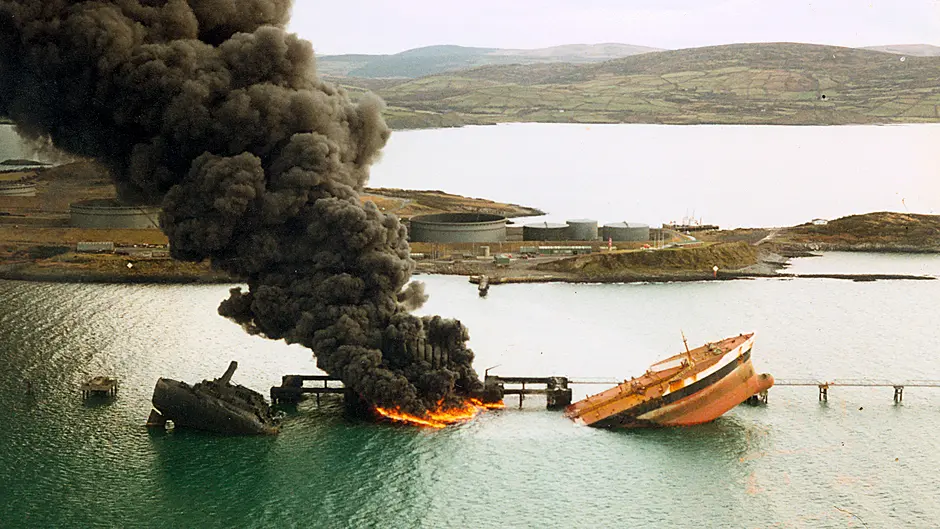EDITOR – In an era when we grapple with climate change and ridding the world of carbon fuels, it’s worth remembering that Ireland was totally dependent on oil to fulfil our energy needs in the past. Arabian crude oil transportation contributed a mainstay to the West Cork economy during the late 1960s and 70s.
Northwest Europe was critically dependent on imported fossil fuels. It was essential to maintain a supply route from the oil rich Arab states. The geopolitical scene was adverse, as Egypt and Israel became embroiled in ‘Gulf Wars’. That debacle caused the closure of the Suez Canal, cutting off the vital shortened shipping route.
Economists battled to find an alternative, and the obvious was the longer route rounding South Africa’s Cape Horn. To be economically viable, the idea was to build super tankers to increase water speeds and save transit times. Bantry Bay had deep bathymetry, and if holding tanks could be erected at Whiddy Island, the problems could be solved. Smaller more navigable ships could then despatch the oil to the likes of Southampton, and Rotterdam.
The Whiddy Whirlwind was born and provided much boosted employment. The construction phase brought a boon. Spin-off industries and suppliers worked in a frenzy. Bantry became a thriving town during this period.
Catastrophically, the Betelgeuse explosion occurred in 1979. Disaster struck on January 8th 1979 at the offshore jetty. The explosion was caused by failure of the ship’s structure while discharging its cargo of crude oil. Later investigations revealed ship unloading guidelines were not observed and the vessel had a poor prior service history.
The incident and inferno claimed the lives of 50 people (42 were French crew, seven Irish nationals, and one British). Only 27 bodies were ever recovered and identified.
The world has now awakened to the need to switch to renewable energy sources and Ireland is playing a lead role in harnessing wind energy. Nearly 40% of our electricity generation now comes from home-produced onshore wind farms.
Plans afoot to place offshore floating wind turbines off the Cork and Waterford coasts might well see this country totally independent of oil importation and self -sufficient from renewables in a decade or two.
Vincent O’ Shea,
Malahide,
Co Dublin.
Salmon report is not based on science
EDITOR – The recent ‘science based’ report to which Billy Smyth of Galway Bay Against Salmon Farming refers has not been peer-reviewed nor is it published in a scientific journal. Much of it is based on mathematically-modelled preconceived perceptions, rather than actual science.
The authors do say that salmon farming is the greatest threat to wild salmon stocks, but they have repeatedly failed to respond to the question as to how an ‘estimated’ mortality of around 30,000 migrating smolts, calculated from their mathematical model, is a much greater threat to the viability of the Norwegian salmon population than the confirmed capture and killing for sport of over 100,000 ready-to-breed returning adult fish.
The publication of Mr Smyth’s letter coincides with that of a new peer-reviewed study that has demonstrated that the declines in wild salmon numbers around Scotland’s west coast aquaculture zone are not the result of impacts with salmon farming, but part of natural changes that are mirrored across all of Scotland.
If catch data from Ireland and Norway was examined in a similar way, it is likely that the same conclusions would also be drawn.
Sadly, there has been so much effort directed at trying to show salmon farming is to blame for all sorts of issues, that no-one has really bothered to actually investigate the underlying reasons for observed changes to marine environment.
The name of Mr Smyth’s organisation clearly illustrates this blinkered vision.
Dr Martin Jaffa,
Callander McDowell,
Stratford,
London E20 1BD.
It ‘sounds’ wonderful
EDITOR – I read over Christmas that Greyhound Racing Ireland (GRI) is to open what they call ‘greyhound care centres’ in four regions around Ireland.
They say that up to the end of last November they helped to rehome 2,000 greyhounds – compared to 1,578 for the same period in 2020.
The new care centres will be to used to prepare retired greyhounds for rehoming and to let the public view the dogs before adopting them.
All the centres will have ‘strict security, hygiene, and welfare standards, including maintaining exercise paddocks, food preparation areas and kennels to the highest standards’ they say. I noticed the security detail is the top of the list, the word ‘welfare’ at the bottom.
They also said the centres’ operators will also be obliged to use social media to promote retired greyhounds for rehoming, to provide regular updates and show photos/video of any training being provided to the greyhounds, to promote successful adoptions and to show photos/video of greyhounds living in their new homes.’
It all sounds so wonderful.
Isn’t it a pity, though, that it took a major investigation by RTÉ to get all these great ideas in place?
I am also in no doubt that the €17.6m (yes, you read that right) given to Greyhound Racing Ireland by the government last October will help alleviate some of the cost of these wonderful centres.
Susan Crowe,
Ballincollig.







